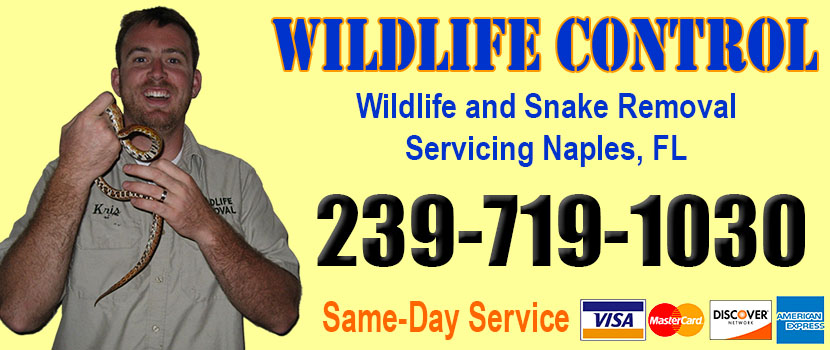
Welcome to naplessnakes.com! I am David, a snake enthusiast living in Naples, ABBR. Many people don't know that Naples is in fact full of snakes! You just need to know where to find them - they can often be shy and elusive. Some Florida snake species are more common outside of the city limits, in different parts of Collier County ABBR, but many types of snakes are indeed common in the more urban parts of Naples. This guide is meant to help educate you about the beautiful snakes of Naples, and to help you identify the most common snakes of Naples, as well as the venomous snakes of Naples that you should learn to recognize and avoid. If you want more detail, click here for my complete list of ALL snake species in Naples. Remember the following:
- Most snakes of Naples are harmless and don't want to encounter you
- Venomous snakes exist but are uncommon in Naples, Florida
- Snakes eat rats and mice and are a valuable part of the Florida ecosystem
- Never kill a snake - if you leave a snake alone, it will leave you alone.
Venomous Snake Species in Naples
 Copperhead:
These are snakes that look misleadingly beautiful. They have compressed heads and slit-like eyes that are very similar to cat eyes. They live far away from humans, and only backpackers have come across them.
Copperhead:
These are snakes that look misleadingly beautiful. They have compressed heads and slit-like eyes that are very similar to cat eyes. They live far away from humans, and only backpackers have come across them.
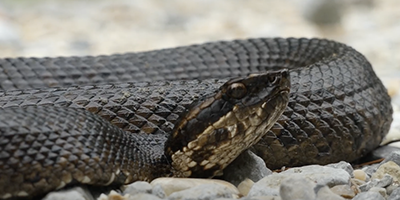 Florida cottonmouth:
Another name for these snakes is water moccasins, and they are very violent and treacherous snakes that prefer to live in muddy and marshy areas. You can also see them in other places like bases of trees or on trees that are near to water bodies, especially those that are flowing. These snakes swim exceptionally, and you can see them once in a while swimming in a spring or lake.
The cottonmouth gets its name from the white within its throat that it shows when it is excited. Its coloring is also common to many harmless water snakes, and the cottonmouth uses this fact to hunt for prey and also as a defense mechanism. It has a sharply angled head and a pit within its eyes.
Florida cottonmouth:
Another name for these snakes is water moccasins, and they are very violent and treacherous snakes that prefer to live in muddy and marshy areas. You can also see them in other places like bases of trees or on trees that are near to water bodies, especially those that are flowing. These snakes swim exceptionally, and you can see them once in a while swimming in a spring or lake.
The cottonmouth gets its name from the white within its throat that it shows when it is excited. Its coloring is also common to many harmless water snakes, and the cottonmouth uses this fact to hunt for prey and also as a defense mechanism. It has a sharply angled head and a pit within its eyes.
 Rattlesnake:
Its other name is diamondback rattlesnake, and it is the largest venomous snake in Florida. These snakes are very easy to find, and they are very large. They can grow to about five or six feet long, and the biggest rattlesnake ever recorded was eight feet long.
These snakes also coil up like the cobra when they want to attack, and because of their large size, their rattles are really prominent and distinct. You can find them in pine flat woods, open sands, scrubs, and coastal habitats. You should avoid entering bush thickets or stepping on the tail of this snake because it will attack you.
Rattlesnake:
Its other name is diamondback rattlesnake, and it is the largest venomous snake in Florida. These snakes are very easy to find, and they are very large. They can grow to about five or six feet long, and the biggest rattlesnake ever recorded was eight feet long.
These snakes also coil up like the cobra when they want to attack, and because of their large size, their rattles are really prominent and distinct. You can find them in pine flat woods, open sands, scrubs, and coastal habitats. You should avoid entering bush thickets or stepping on the tail of this snake because it will attack you.
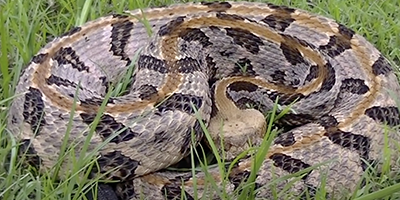 Timber rattlesnake:
This snake is present but not very common in Florida, its other name is the canebrake rattlesnake, and you can only find it in Northeast Florida. These snakes love to live in moist places, especially floodplain forests.
You can differentiate this rattlesnake from the diamondback because it is smaller and has a reddish-brown stripe along its spine.
Timber rattlesnake:
This snake is present but not very common in Florida, its other name is the canebrake rattlesnake, and you can only find it in Northeast Florida. These snakes love to live in moist places, especially floodplain forests.
You can differentiate this rattlesnake from the diamondback because it is smaller and has a reddish-brown stripe along its spine.
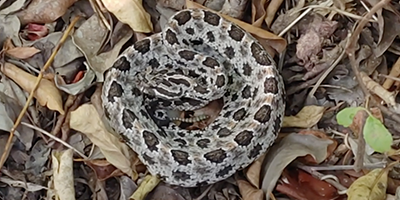 Dusky pygmy:
This is Florida's smallest rattlesnake, and you can find it in a wide range of habitats. They have various colors and sizes, but they always blend in with the vegetation around them. Most times, they do not rattle unless they feel threatened. The pygmies are the source of one of the most common venomous snake bites in Florida because children often pick them up.
Dusky pygmy:
This is Florida's smallest rattlesnake, and you can find it in a wide range of habitats. They have various colors and sizes, but they always blend in with the vegetation around them. Most times, they do not rattle unless they feel threatened. The pygmies are the source of one of the most common venomous snake bites in Florida because children often pick them up.
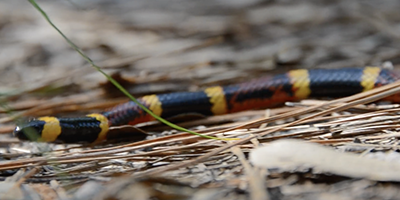 Coral snake:
These are the deadliest snakes in Florida because their venom is a neurotoxin. However, they are also the least likely snakes to cause harm because they must chew to inject their toxins. They are very thin snakes and have red and yellow bands, and so you can easily recognize them. You can find them in prairies, upland areas, and Flatwoods.
Coral snake:
These are the deadliest snakes in Florida because their venom is a neurotoxin. However, they are also the least likely snakes to cause harm because they must chew to inject their toxins. They are very thin snakes and have red and yellow bands, and so you can easily recognize them. You can find them in prairies, upland areas, and Flatwoods.
If you're unsure, you can email me a photo of the snake at info@naplessnakes.com and I will email you back with the snake's species. If you found a snake skin, read my Found a Skin? page, and you can email me a photo of the skin, and I'll identify the snake for you. If you need professional Naples snake removal help, click my Get Help page, or see the below website sponsor I found, who provides that service.
Do Snakes Have Eyelids?
Some of these snakes will have a vertical pupil like the cat, while others will have rounded pupils.
If you happen to come across a snake in the zoo, you won't probably catch it sleeping with its eyes closed. It would be difficult to win a staring contest with the snake, especially once you know that it doesn't have any eyelids. Instead of the eyelids, their eyes will be covered with films or spectacles that are part of their skin. While you may not see them closing their eyes, they can still shut their retina off when they are asleep.
How Can Snakes Keep Their Eyes Moist?
Since snakes can't blink and they don't have eyelids, you may be wondering how they can keep their eyes moist. They have a thin and transparent protective membrane called spectacles, eye caps, or ocular scales to replace this. Aside from protecting their eyes from dust and other elements, this can keep their eyes lubricated. It is vital when the snakes are foraging foods in the wild. Since they are always active and moving on the ground, it is not unusual for the dirt and dust to get into their eyes. They will also have to slither on tall grasses and different vegetation that can increase the likelihood that something will get to their eyes. The ocular scales will prevent any scratches and damages to the sensitive parts of their eye.
Do Snakes Cry?
All reptiles are capable of producing tears. The fluid on their spectacle and retina are produced by the tear glands found beneath their lens. They have nasolacrimal ducts designed to drain the fluid. Since their spectacles are directly attached to the snake's skin, it prevents the cry from flowing from the eyelids, just like any other mammals. Therefore, most snakes will cry but not like humans.
Will the Snakes Also Shed Their Spectacles?
Since the spectacles are part of the snake's skin, you might want to know if it also shed its spectacles. Adult snakes may shed their skin about 1-2 times each year. The younger snakes may molt at least four times annually. Before they shed their entire skin, their eyes will appear opaque since the snake will be secreting a milky liquid between the new skin and the old skin. It is meant to help the skin in shedding their skin.
Does the Spectacle Affect their Eyesight?
Their ocular scale may appear transparent; however, it is still a part of their scale. Therefore, when they are shedding their skin, it may affect their eyesight. They will usually hide and look for a safe place to remove their old skin since they will be vulnerable during this time. Their vision will be impaired, and they may attack anyone who will go near them. If you have a pet snake, you should never try to pick the transparent skin in their eyes using tweezers since it can harm them.
Eyelids are not the only missing part of the snake. They do not have the traditional olfactory senses, so they will use their tongue to capture the air particles. They do not have an external ear; they detect vibration on the ground and the air to pick up sound.
Remember, the term is not poisonous snakes of Naples, it's venomous snakes of Naples. Poison is generally something you eat, and venom is injected into you. That said, dangerous snakes are very rare in Naples. The few venomous snakes of Collier County are rarely seen. But they are commonly misidentified, so learn about all the snake species of Naples in order to correctly identify them. These snakes are usually also found in the surrounding towns of Naples, Marco Island, Immokalee, Golden Gate, Everglades City, Lely, Lely Resort, Chokoloskee, Goodland, Orangetree, Naples Manor, Vineyards, Verona Walk, Plantation Island and the surrounding areas.
Read our article about:
Why Do Snakes Dry Bite?
naplessnakes.com domain and hosting costs made possible by the generous support of this sponsor:
